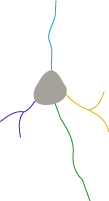Individual tree (branched structure)

Use to view results for morphometric features grouped by dendrite or axon.
To see these results also broken down by branch order, use Each Tree analysis.
Analysis results
Total length for all branches in the tree.
- Mean = [Length] / [Number of branches]
- Variance: Set to 0 if there is only 1 branch. Otherwise computed for the set of branches.
Computed by modeling each branch as a frustum (truncated right circular cone).
- Mean = [Surface] / [Number of branches]
- Variance: Set to 0 if there is only 1 branch. Otherwise computed for the set of branches.
Computed by modeling each branch as a frustum (truncated right circular cone).
- Mean = [Volume] / [Number of branches]
- Variance: Set to 0 if there is only 1 branch. Otherwise computed for the set of branches.
The nodes are computed according to the number of segments of that order ending in nodes and the degree of the node.
A node is assigned to the segment leading to the node.
Degrees (0, 1, 2, >2):
- Termination: degree 0.
- Bifurcation: degree 2.
- Nodes of degree higher than 2 are grouped.
Quantities are computed according to their type: normal (N), high (H), low (L), incomplete (I), origin (O), midpoint (M), and generated (G).
The types were selected while tracing in Neurolucida.
| Normal Ending (N) | Default |
| High Ending (H) |
Ending located at the top of the current section. Depending on the orientation of the sections, the process may continue into another section.
|
| Low Ending (L) | Ending located at the bottom of the current section. |
| Incomplete (I) | Use to label arbitrary endings, endings that disappear for unknown reasons, endings that should be audited later.. |
| Origin Ending (O) |
Indicates the directionality of the tree.
Neurolucida Explorer keeps track of directionality to apply branch orders. |
| Midpoint (M) | Ending of a long branch that is indeterminate at the time it is placed. |
